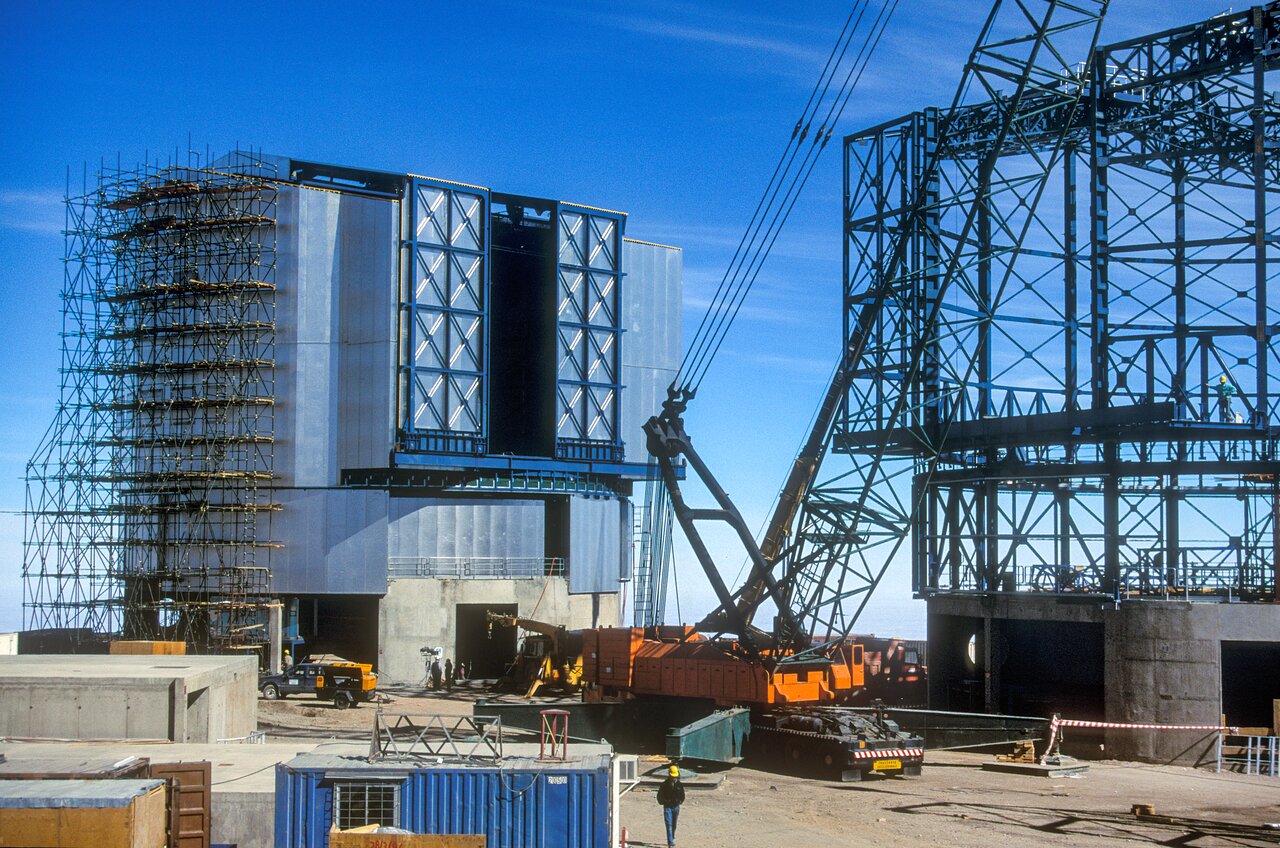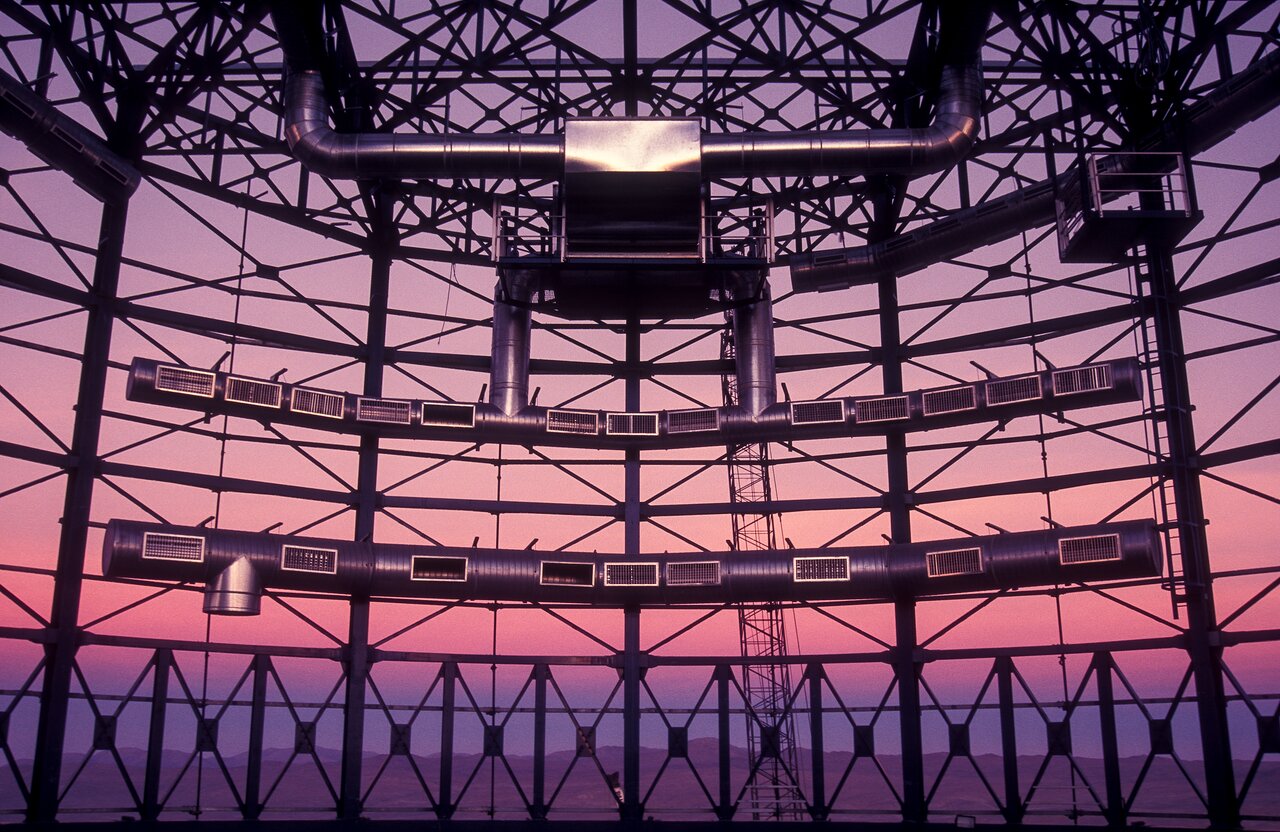
Paranal Perspectives
How ESO’s flagship observatory has changed over time, through the eyes of engineer and photographer Gerhard Hüdepohl
- How ESO’s Paranal Observatory has changed over time
- What some of Paranal’s milestones have been
- How Gerhard Hüdepohl’s photography has documented the story of Paranal
“I still have it here, on my shelf!” Gerhard holds up his Praktica, a purely mechanical reflex camera that he was given by his father at the age of fifteen. “It still sort of works. I wouldn’t bet that it still exposes correctly, but it’s a nice memory to have.”
When his father bought himself a new camera, giving Gerhard his old Praktica, it was the start of a life-long passion. “From there on I was hooked,” he says. “From my father, who developed his own film at home, and with friends, I continued to learn and improve. It’s been a never-ending process ever since.”
Gerhard took photographs whenever he could. After studying electronic engineering at university, he worked as a commissioning engineer in several countries, including China, Australia, and South Korea, providing plenty of chances for inspiration. His first time in Chile, however, was as a tourist. It was on this trip that he caught his first glimpse of ESO, in the form of La Silla — the oldest of ESO’s observatories.
“I was in Chile in '94”, he recalls, “on a bus to the north. From the window I saw La Silla, and I remember thinking, ‘wow, that’s somewhere I would like to work.’ These huge telescopes that were used to understand the secrets of the stars really caught my attention.”
Construction of the VLT at ESO’s Paranal Observatory, 500 kilometres north of La Silla, began in 1991, but it wasn’t until the majority of concrete and steel work was complete that opportunities arose for electronic engineers. From Malaysia, where he was working at the time, Gerhard applied to work for ESO.
“Although I always had an interest in the Universe, I think I was more interested in these giant, perfect machines than in astronomy. These telescopes have the weight and size of a ship, but have to work to a precision of within a few thousandths of a milimetre. I find that fascinating”. [1]
The early days of Paranal
“I joined ESO in 1995, and in my first years I was working as part of the Assembly, Integration and Verification team of the VLT,” says Gerhard. “The priority was to reach the first light on schedule.”
At a time when the telescopes were still under construction, the atmosphere at Paranal was unique. The Residencia — the futuristic-looking lodge where ESO staff now reside when working on-site — had not been built yet, so everyone was living in the adjacent basecamp. And in this early stage of construction, priorities could change at short notice.
“Living and working together, in such an isolated location, really welds the team together. You depend on each other, and there’s no escape. It’s a little bit like being on a ship in the middle of the ocean — if you don’t row together, the ship won’t go anywhere.”
One of the most important milestones for Paranal was the first light of the VLT’s Unit Telescope 1, Antu, in 1998. Unsurprisingly, this was one of Gerhard’s most memorable moments from his time at the observatory.
“Late one evening, after many months of assembling and testing the telescope, we opened the large observing slit doors of Antu’s dome for the first time, and pointed the telescope to the stars.
This huge telescope moved silently around its axes to the sky. That moment I will never forget.”
Collecting photons
Construction of the remaining telescopes continued over the years, and the observatory transitioned into the operations stage, with the telescopes already collecting scientific data. Gerhard’s role also evolved, as he eventually became the Head of the Electronic Group within Paranal’s Engineering Department.
“The task was to keep the observatory in operation, make the systems robust and minimise losing observing time due to technical issues,” he says. “A typical day started by reviewing technical problems that had occurred during the previous night, and solving them with the team.” But this is easier said than done! As Gerhard explains: “In these very complex telescope systems where many sub-units have to work perfectly together, you always encounter technical challenges, sometimes more than you would wish for. To finally resolve this type of problems was always a challenge but also rewarding for everybody who was involved in the trouble-shooting.”
The daily routine at Paranal also includes a special team-bonding moment just before night falls. “At sunset it is a tradition that always some people gather at the observatory platform to view the sun sinking into the Pacific Ocean.”
La Residencia
Inaugurated in 2002, La Residencia at ESO’s Paranal Observatory provides a welcome retreat from the harsh environment of the Atacama Desert. When you work in one of the driest places on Earth, the humidity provided by the oasis under the Residencia’s dome is a much-needed relief.
“It was really nice to have a permanent room there,” says Gerhard. “As well as a gym and a swimming pool!”
The Residencia has also welcomed guests beyond the engineers and astronomers working on site. Its exterior was featured in the 2008 James Bond film, Quantum of Solace.
Gerhard was at Paranal during the filming, and had the fortunate opportunity to be involved in some behind-the-scenes work. “Below Paranal there is a small airstrip which was used in a scene, and they required some planes for decoration. At the time I had a pilot’s license, so I flew a small plane in from Antofagasta, which appears in the movie for a few seconds!”
Different views of Paranal
Gerhard’s pilot’s license came in handy on more occasions than the filming of Quantum of Solace. Several of his Paranal photographs, many of which can be found on the ESO image archive, were taken from the air.
“One of my favourite photos, a very old one, shows Paranal in front of a snow-covered Llullaillaco''. The world’s highest historically active volcano, Llullaillaco, lies on the border between Chile and Argentina. On clear days, it can be seen from ESO’s Paranal Observatory.
“There was a day when I happened to fly, when it had recently snowed, and when the skies were very clear. I got this picture, taken on film. I’ve tried several times to repeat this picture on digital, but could never get it exactly right.”
“But I think my favourite photo is one I took with a drone, between the four laser beams of Yepun,” he says, referring to the VLT’s Unit Telescope 4. “It took quite some preparation, and several attempts, to get the image I had in mind.”
These lasers create four artificial “stars” high up in the atmosphere, which are then used to measure and correct the atmospheric turbulence, allowing the telescope to capture crisp images. To take this stunning shot, Gerhard had only a time slot of around ten minutes when it was dark enough to see the lasers, yet light enough for the surrounding desert to be visible. After many attempts, Gerhard captured this spectacular image, which was featured in the National Geographic magazine. “For a photographer, this is something like the Oscars!”
What’s next for Paranal?
“Another memorable moment from my time at ESO was during 2019, my last year”, Gerhard describes. “I was able to follow the first part of the construction of the ELT. At one moment, I realised that this stage of construction I was seeing was roughly the same as that of Paranal, when I first started working there. For me, it closed a cycle”.
At Cerro Armazones, just 25 kilometres from Paranal, ESO is building the Extremely Large Telescope (ELT). As the largest infrared and visible light telescope in the world, the ELT will be revolutionary for astronomy. However, it is by no means the end of Paranal’s story. An exciting host of upcoming instruments, as well as upgrades to existing infrastructure, will open up new windows to continue studying the universe from Paranal. Moreover, the ELT will be operated from Paranal as well.
“To be able to work in a unique environment such as the Paranal Observatory was always very inspiring for me, both as an engineer and also as a photographer. What is very rewarding for me as an engineer is to see when “my” telescope is pointing to the sky at night, delivering high quality scientific data. When you then hear that a Nobel Prize was awarded for a discovery that was made with that same telescope, and you were often even there during these observing runs, that is particularly exciting. You somehow feel that you have contributed a very small grain to that achievement.”
Although Gerhard retired from ESO in 2019, he still publishes photographs from Paranal on his website and Instagram account.
“I sometimes get comments from people saying ‘wow’, I’d really like to visit or even work at this place. I hope that this can spark an interest in astronomy, astrophotography or engineering in people who see these photos”.
Note
[1] The movable structure of each VLT Unit Telescope weighs about 430 tonnes and is so well-balanced and well-oiled that it can be moved by hand.
Numbers in this article
| 1991 | The year that VLT construction began |
| 1998 | The year that Antu (UT1) saw first light |
| 1999 | The year Paranal was inaugurated |
| 2002 | The year that the Residencia was inaugurated |
Biography Anna Purdue
Anna Purdue is a science journalism intern at ESO. Prior to this she has completed a BSc in Physics with Astrophysics from Northumbria University (UK) and an MSc in Science Communication from the University of Edinburgh.










